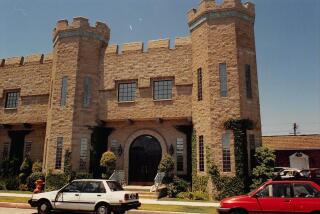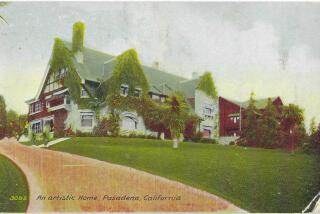Tarzan Has a Place He Can Call Home
In 1919, author Edgar Rice Burroughs received a visitor at his 550-acre California goat ranch, recently purchased with the profits from his creation of a popular fantasy character, Tarzan of the Apes.
Although Burroughs preserved records of almost every aspect of his busy life, he failed to record the visitor’s name, but he wrote to a friend:
“A guy bobbed up day before yesterday with the plan of a whole village he wished to plant in my front yard--school, city hall, banks, business houses, motion picture theater--and it was labeled City of Tarzana.”
The idea was too much even for Burroughs, whose hothouse imagination created worlds inside the Earth and dying empires on Mars, making him wealthy and famous as one of the first modern fantasy and science fiction writers.
The San Fernando Valley was then mostly a collection of small produce farms and ranch land, with a mountain range separating it from Los Angeles. His own ranch, actually a country estate with a palatial main house, was supposed to pay for itself through raising goats and hogs.
The City of Tarzana, he commented, “sounds like a steamboat.”
But he did have a warm feeling for Tarzan, the fictitious Lord of the Jungle who brought Burroughs success after years of failing at other jobs and business ventures, and so he named the place Tarzana Ranch.
Although it has been years since the unknown promoter’s vision came true, the memory of Tarzan, the English nobleman raised in the jungle by apes, is still alive in Tarzana, the Los Angeles suburb named after him.
A Tarzana branch of Valley Federal Savings & Loan on Ventura Boulevard maintains a small museum of Tarzan and Burroughs memorabilia--movie posters, new and old editions of his books, photos of almost all the actors who have played Tarzan in movies and on television, a photocopy of the first page of the first Tarzan manuscript, blowups of Sunday comic strips and such oddities as a meerschaum pipe carved with the image of Tarzan and a friendly lion.
There is a smaller exhibit of Tarzan paintings in a Ventura Boulevard office of the Bank of America.
And across the street from the bank, in the same Spanish Mission-style bungalow Burroughs built as an office in 1927, is the source of material for both exhibits. It is the headquarters of Edgar Rice Burroughs Inc., the company Burroughs formed to market the torrent of fiction he wrote, including 97 novels and dozens of short stories.
The ashes of Burroughs are buried under a walnut tree in the front yard, beside the busy commercial boulevard that was a rural road when he worked on Tarzan books there.
There is no identification on the building, a modest single-story leftover from another era in the lineup of tall, glass-walled office buildings on the boulevard.
It is “a multimillion-dollar corporation,” said Danton Burroughs, 40, grandson of the writer and director of the corporation, “but we don’t tell anyone exactly how much money is involved.”
“It’s a privately held corporation, and we like to keep a low profile.”
All the owners and two of the corporation’s seven employees are children, grandchildren and great-grandchildren of the writer, he said.
“My grandfather incorporated in 1923, one of the few authors to do that back then,” Danton Burroughs said, and the corporation owns Tarzan as a trademarked character, which it can hold in perpetuity.
Merchandising Tool
In addition to books and movies, Tarzan is still sought as a merchandising aide, Danton Burroughs said, and the name is now on a wide variety of goods around the world, from T-shirts and stuffed animals to a video game and vitamins.
Better yet, he said, the latest of the 47 Tarzan movies, “Greystoke: The Legend of Tarzan, Lord of the Apes,” has been released on videotape cassettes and “is among the top 10 best selling and renting tapes.”
The corporation gets a percentage of the film’s profits, he said, although he would not say how big. The Burroughs family was delighted that the script reflects in large part the original story that Edgar Rice Burroughs first published in All-Story Magazine in 1912. He received $700 for the creation of what turned into one of the most popular fictional characters of the 20th Century.
Most of the original Tarzana Ranch, which ran south from Ventura Boulevard into the Santa Monica Mountains between Reseda Boulevard and Avenida Oriente, is now occupied by the Cedar Hill Nursery and Caballero Country Club.
Boom-and-Bust Career
Edgar Rice Burroughs, a golf enthusiast, was responsible for the founding of the country club in 1924, when--by now converted to the vision of the unnamed visitor in 1919--he set out to convert the ranch into a suburban subdivision. It was one of the many ventures that helped bring on repeated financial troubles in his boom-and-bust career, including a money-losing investment in an airfield that is now Van Nuys Airport.
By that time, the Tarzan books were selling by the thousands in 33 languages, there was a Tarzan comic strip in 250 newspapers and a radio show, and there were other Burroughs characters in books and films, such as the “John Carter of Mars” series. He wrote 97 novels. The corporation has part of another, unfinished one in its files.
Burroughs also wrote in the 1920s for the Tarzana Bulletin, a real-estate promotion flyer. Tarzan may have been a mighty hunter, but Burroughs had no love for hunting in Tarzana, then still largely a rural area, and thundered in his columns against “heroic sportsmen” shooting doves, “these fierce denizens of the stubble fields.”
The Post Office accepted the name Tarzana for the suburb in 1930, ending seven years of conflict between backers of that name and Runnymede, a nearby rival subdivision.
Although Runnymede was bigger--75 homes and some small businesses, compared to five homes in Tarzana, including Burroughs’ ranch--when the first inspection was made by the Post Office, it was handicapped by the existence of other Runnymedes in Kansas and New Jersey.
Burroughs argued in a letter to postal authorities, “So far as I know, there would not be another Tarzana in the world.”
Tarzan on Letterhead
A sketch of Tarzan still decorates the letterhead of the Tarzana Chamber of Commerce, a sign of victory over the chamber’s original name, the Runnymede Poultry and Berry Assn.
The Burroughs family lived in the hilltop estate house, bought in 1919 from the estate of the owner and publisher of the Los Angeles Times, Harrison Gray Otis, until 1924, when it became the El Caballero clubhouse. It was razed in the 1940s, Danton Burroughs said.
The family, which moved often, lived in Los Angeles for a while, but returned to Tarzana in 1926, building a modest frame house at 5046 N. Mecca Ave. from which they could see their former mansion on the hill. They lived there until moving to Malibu in 1932.
Burroughs returned to the Valley after spending most of World War II as a war correspondent based in Hawaii. Ironically, the popularity of the Tarzan character was going into a slump and he could not find a house he liked and could afford in Tarzana.
He died in 1950 at the age of 74, leaving behind written instructions that his ashes were to be buried in Tarzana “under the big black walnut tree on my pet lot,” site of the headquarters of the company he founded.
The character’s popularity rebounded later, in part because of television, changing tastes, new films and a brief scandal in 1962 when a teacher or librarian condemned the Tarzan books because Tarzan and Jane appeared to be living in sin, Danton Burroughs said. Actually, he noted, they were married in the second book of the series, written in 1915.
The appeal that his grandfather tapped will probably carry Tarzan’s popularity far into the future, Danton Burroughs predicted.
“He’s a timeless, ageless character--natural man at peace with himself, living in the jungle in total freedom. A lot of people can relate to that kind of character, that escapist thought, getting away from all the hectic nonsense of civilization.”
More to Read
Sign up for The Wild
We’ll help you find the best places to hike, bike and run, as well as the perfect silent spots for meditation and yoga.
You may occasionally receive promotional content from the Los Angeles Times.






